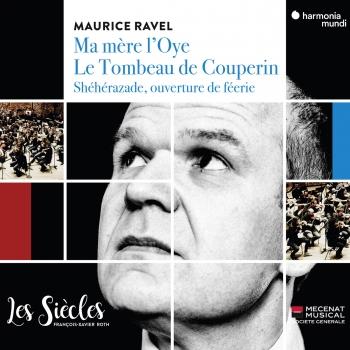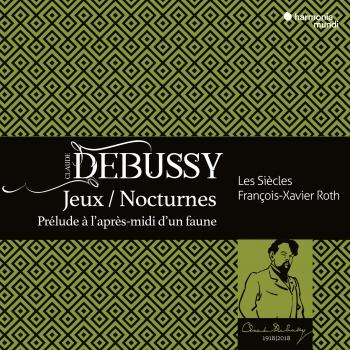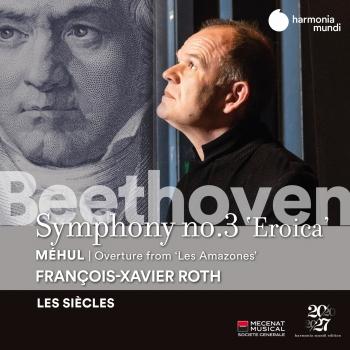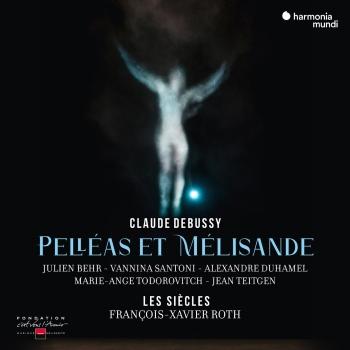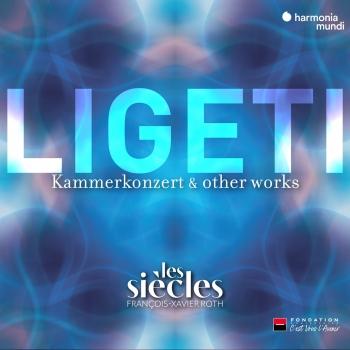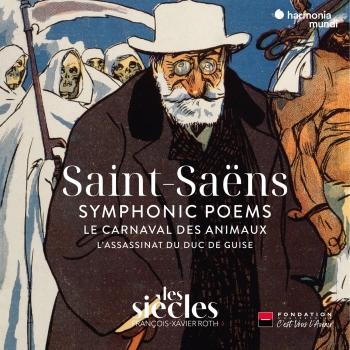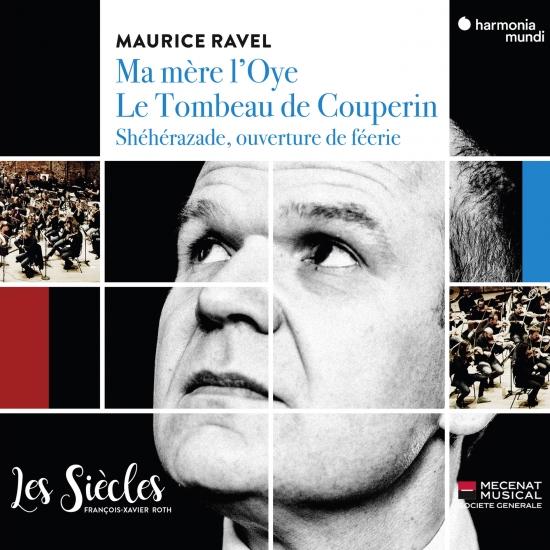
Ravel: Ma Mère l'Oye, Le tombeau de Couperin & Shéhérazade, ouverture de féerie Les Siècles & François-Xavier Roth
Album info
Album-Release:
2018
HRA-Release:
13.04.2018
Label: Harmonia Mundi
Genre: Classical
Subgenre: Chamber Music
Artist: Les Siècles & François-Xavier Roth
Composer: Maurice Ravel (1875-1937)
Album including Album cover Booklet (PDF)
- Maurice Ravel (1875 - 1937): Ma Mère l'Oye, M. 62:
- 1Prélude. Très lent03:05
- 2Ma Mère l'Oye, M. 62, Premier tableau: I. Danse du rouet et scène. Allegro01:58
- 3Interlude. Un peu moins animé01:15
- 4Ma Mère l'Oye, M. 62, Deuxième tableau: II. Pavane de la Belle au bois dormant. Lent01:38
- 5Interlude. Plus lent00:50
- 6Ma Mère l'Oye, M. 62, Troisième tableau: III. Les Entretiens de la Belle et de la Bête. Mouvement de valse modéré04:00
- 7Interlude. Lent00:40
- 8Ma Mère l'Oye, M. 62, Quatrième tableau: IV. Petit Poucet. Très modéré03:32
- 9Interlude. Lent01:20
- 10Ma Mère l'Oye, M. 62, Cinquième tableau: V. Laideronnette, impératrice des pagodes. Mouvement de marche03:24
- 11Interlude. Allegro01:07
- 12Apothéose. Le jardin féerique. Lent et grave03:35
- 13Shéhérazade, ouverture de féerie, M. 1713:13
- Le Tombeau de Couperin, M. 68a:
- 14I. Prélude. Vif03:00
- 15II. Forlane. Allegretto05:39
- 16III. Menuet. Allegro moderato04:42
- 17IV. Rigaudon. Assez vif03:16
Info for Ravel: Ma Mère l'Oye, Le tombeau de Couperin & Shéhérazade, ouverture de féerie
„Musikalische Sternekost“ und ein „Fest des Klangsinns“ (Spiegel Online): Für den Auftakt ihres Ravel-Zyklus für harmonia mundi mit „Daphnis et Chloé“ erhielten François-Xavier Roth und sein Orginalklang-Ensemble Les Siècles hervorragende Besprechungen und mehrten ihr Renommee als Spezialisten für die farbenreichen Partituren des Franzosen. Jetzt erscheint bei harmonia mundi nun die Fortsetzung: Mit einem von Ravels früheren Werken, „Shéhérazade, ouverture de féérie“, sowie zwei seiner bekanntesten Kompositionen, „Ma mère l’oye“ und „Le Tombeau de Couperin“, erwarten den Hörer drei ursprüngliche Klavierwerke, die Ravel mit Meisterschaft orchestrierte und die Roth und seine Musiker so authentisch wie sinnlich erlebbar machen.
Wenn es um Maurice Ravel geht, kennt François-Xavier Roths Faszination kaum Grenzen. Jedes seiner Werke sei einzigartig und außergewöhnlich, so der französische Dirigent, strebte Ravel doch stets danach, neue musikalische Wege zu beschreiten und Formen auszuprobieren, die in noch keinem seiner vorangegangenen Werke zu finden sind. Die neue Einspielung für harmonia mundi vereint drei Werke, die das besonders deutlich zeigen.
„Shéhérazade“, die selten gespielte „Feen-Ouvertüre“ des erst 24jährigen Ravel, erhielt bei ihrer Uraufführung 1899 sowohl Beifall als auch Buhrufe – Ravel selbst, obwohl zunächst noch überzeugt von dem Werk, verbot später die Publikation, weshalb die Veröffentlichung erst 1975 folgte. Dabei zeigt das Stück deutlich die Entwicklung des Komponisten: In märchenhaften und exotischen Elementen der Musik spiegelt sich Ravels lebenslange Faszination für den Orient und verweist in seinem charakteristischen Stil bereits deutlich auf spätere Werke wie „Daphnis et Chloé“ oder „La Valse“.
Märchenhaft klingt auch die Ballettmusik „Ma mère l’oye“, eines der bekanntesten Werke Ravels und Beweis für sein singuläres Talent, Werke zu orchestrieren und dabei so klingen zu lassen, als seien sie von Beginn an für große Besetzung geschrieben. Es entstand während eines Aufenthalts im Landhaus einer befreundeten Familie, deren zwei Kinder Ravel oft hütete und denen er Geschichten erzählte. So basiert auch „Ma mère l’oye“, das den beiden Kindern gewidmet ist, auf Erzählungen und feierte 1910 als Klavierwerk und 1912 ergänzt und orchestriert als Ballett seine Premiere. Ravel zeigt sich in der Suite von seiner kindlichen Seite, die raffiniert und verspielt, dabei voller Details, fantastische Klangwelten erschafft.
Eine andere Art von Intimität wird schließlich in „Le Tombeau de Couperin“ hörbar, dem dritten Werk der Aufnahme: Maurice Ravel widmete jede der sechs Kompositionen einem seiner im Ersten Weltkrieg gefallenen Freunde. Uraufgeführt im April 1919 und zwei Monate später durch Ravel für Orchester eingerichtet, ist die Suite weniger Hommage an François Couperin, sondern an die französische Musik des 18. Jahrhunderts selbst. So bezieht sich jedes Stück auf einen barocken Tanz und zeigt nostalgisch und melancholisch, aber auch lebhaft und virtuos, Ravels Vorliebe für klassische Formen und sein Können darin, Musik vergangener Epochen neues Leben einzuhauchen und so den Charme früherer Zeiten wiederzubeleben.
Für die Interpretation dieser innigen und dabei so differenzierten Musik kommt Les Siècles die spezifische Spielweise des Ensembles zu Gute: Erst durch Einsatz des Instrumentariums aus Ravels Zeiten wird deutlich, wie der Komponist jede Instrumentenfarbe bis an die Grenzen der Spielbarkeit ausreizte, dabei aber nie den Blick auf das große Ganze verlor und die Instrumente mit ihren Timbres abstimmte und variierte. So machen Les Siècles die Klangvorstellungen Ravels nachvollziehbar – und wahrscheinlich gibt es derzeit kaum ein Orchester, das diese Musik so authentisch und farbenreich spielen kann wie François-Xavier Roths 2003 gegründetes Ensemble.
Les Siècles
François-Xavier Roth, Dirigent
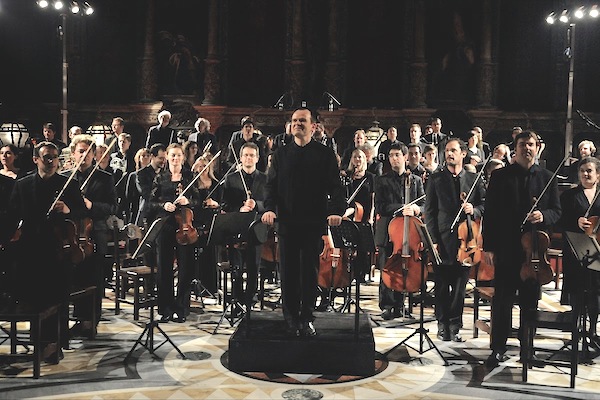 Les Siecles & Francois-Xavier Roth
Les Siecles & Francois-Xavier Roth
Formed in the summer of 2003 by François-Xavier Roth, Les Siècles comprises outstanding young players pooled from the very finest French ensembles. Roth’s founding ambition was for his orchestra to offer a new approach, not only to repertoire but also to the nature of the concert form.
With a vast period-instrument collection at its disposal, spanning the baroque, classical, romantic and modern eras, the orchestra’s repertoire is notably wide in range. Les Siècles is one of a small number of ensembles to employ period and modern instruments, playing each repertoire on appropriate instruments. Its flexible and historically informed work delivers a unique strand of creative programming.
François-Xavier Roth and the musicians of Les Siècles have made a distinctive mark at home and abroad, presenting an orchestra for the 21st century. They have given well over 600 performances in France alone, including regular performances in Paris Philharmonie and appearances at leading festivals throughout France. In addition to its work in France, Les Siècles is increasingly visible on the international scene. Its global profile has been magnified in recent seasons with concerts in Belgium, the Netherlands, Luxembourg, London, Germany, Portugal, Italy, China and Japan.
Les Siècles are associated artist in Paris Philharmonie.
Les Siècles are also in residency in the Aisne department, associated artist at La Cité de la Musique de Soissons and give regularly concerts in Sénart, Nîmes, Amiens, Caen, Royaumont, La Côte-Saint-André, Aix-en-Provence and in other places as London (BBC Proms, Royal Festival Hall), Amsterdam (Concertgebouw), Berlin (Konzerthaus), Bremen, Bruxelles (Klara Festival), Montecarlo, Wiesbaden, Köln, Luxembourg, Tokyo, Essen…
Their recordings of the three Stravinsky’s ballets (L’Oiseau de Feu, Petrouchka et le Sacre du Printemps) received the Jahrespreis 2015 der Deutschen Schallplatten Kritik and won the Edison Klassiek award in Holland. Their Debussy disc was elected Sunday Times Disc of the year and Editor’s choice in the BBC Music Magazine and Gramophone. In march 2017, Les Siècles started to work with Harmonia Mundi label for their last release : Ravel’s Daphnis & Chloé. The disc received many awards : Gramophone Editor’s choice june 2017, Rondo Magazin CD des Monats may 2017, Music web international recording of the month, 5 stars of Diapason, FFFF of Télérama, Le choix de France Musique, la Clé du mois de Resmusica, The Arts Desk Cd of the week, Supersonic Pizzicato, Top Mezzo, Limelight magazine’s five stars.
The musicians of Les Siècles propose regularly several educational actions in schools, hospitals, retirement homes and prisons. The orchestra is partner of Jeune Symphonie de l’Aisne, Jeune Orchestre Européen Hector Berlioz and Demos (musical and social educational project) in Hauts-de-France and Île-de-France. The orchestra is one of the initiator of “Music in the hospital” project proposed in the pediatric haematology-oncology Trousseau Hospital’s service in Paris. He also created an educational residency in La Petite Bibliothèque Ronde de Clamart.
Les Siècles are also the creator and the main feature of the TV show « Presto » which has been broadcast regularly on France 2 since 2007.
Mécénat Musical Société Générale is the main sponsor of Les Siècles.
The orchestra is also financed by the French Ministère de la Culture et de la Communication and DRAC Hauts-de-France. Since 2011, the orchestra is supported by the Département de l’Aisne to reinforce its artistic and educational presence on this territory, especially in the Cité de la Musique de Soissons. The orchestra regularly performs in Hauts-de-Seine with the support of the city of Nanterre. Les Siècles is resident orchestra in Théâtre-Sénart of Lieusaint, and associated artist in Théâtre de Nîmes, Théâtre du Beauvaisis, Les Musicales de Normandie festival and the Berlioz Festival of La Côte-Saint-André.
The orchestra is sponsored by the Palazzetto Bru Zane-Centre de musique romantique française, the Echanges and Bibliothèques association and occasionally by the SPEDIDAM, ADAMI, Bureau Export, Institut Français, SPPF and FCM.
Les Siècles is administrator member of the FEVIS and the Association Française des Orchestres, then associated member of SPPF.













